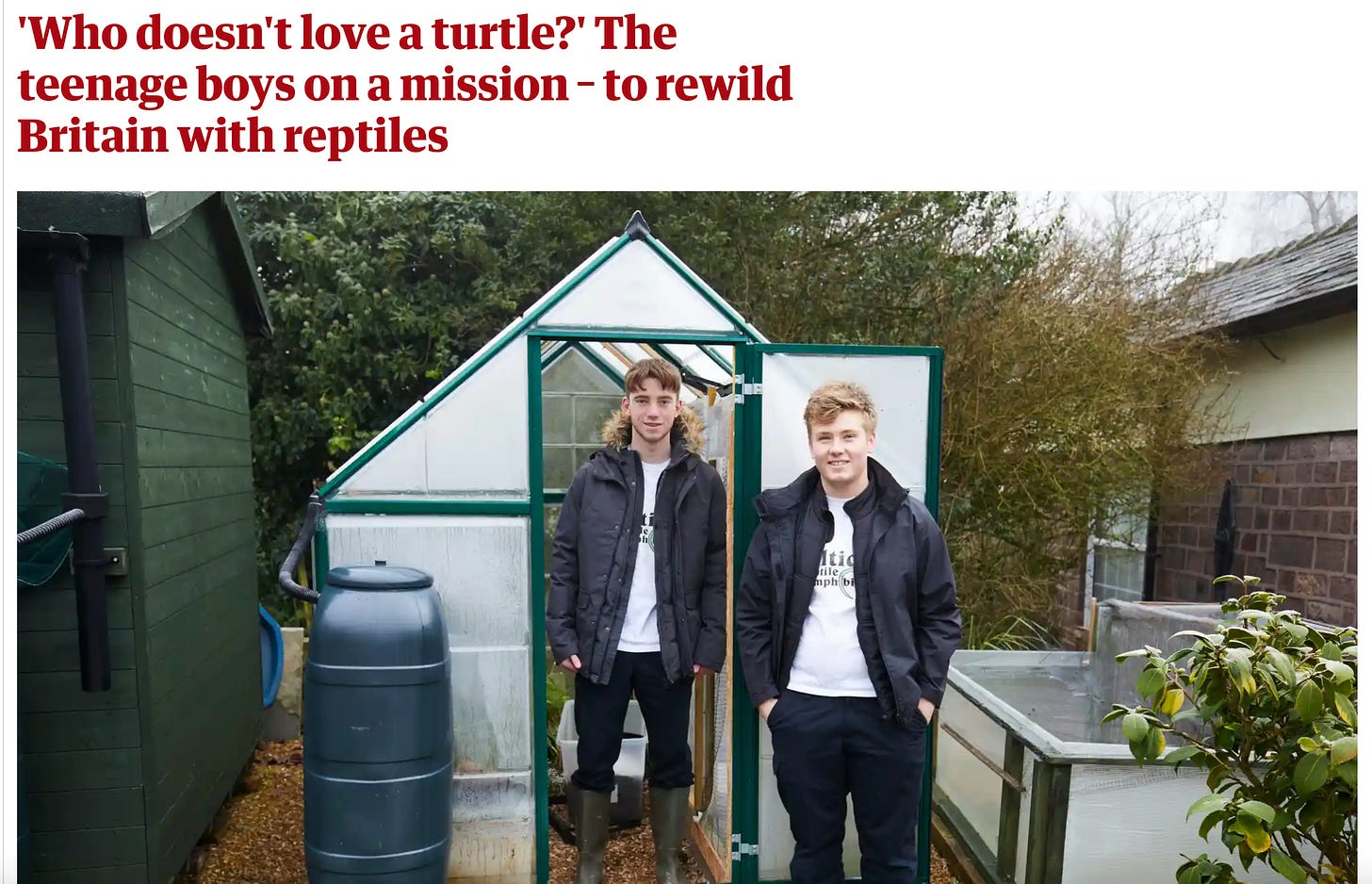The Manuals: The start of something big
We're building a handbook of blueprints for practical rewilding
Trolley Reef - by Something & SonHi - this looks like the beginning of something big. Just over a week ago, the United Nation set the clock ticking for the ‘Decade on Ecosystem Restoration’, a plan to rewild a massive area, about the size of China, spread out across the planet. The hope, now, is that we can come together to build a global movement to re-imagine, recreate and restore ecosystems.
In announcing this decade-long project, UN coordinator Tim Christophersen said it is high time for “imagination”. Our project, The Manuals, has decided now is the time to help launch a public conversation about how we can each play a role in imagining, designing and building a restored planet.
Each month, we’re sending an email of imagination-provoking things: inventions that are supporting non-human species around the world, plus stories and how-to guides from around the world.
For more than a year, we’ve been talking to the people on the frontlines of ecosystem restoration — from gardeners to ecologists, from school kids to policymakers — with the aim of turning rewilding into a new creative practice, accessible to all.
We’ll be sending more ideas, and explaining more about our goals (check out themanuals.org to know more right away). But more than anything, we want to have a two-way conversation.
This is a kind of Issue #0 for the people who have already backed us or followed us. If you have an idea for ways to restore the planet, we’re looking to connect further with you. If you’re keen to be involved, please don’t hesitate to drop me an email at mjponsford@gmail.com.
If you find something you like in this newsletter, please (please!) share it with someone who might also like it, and follow The Manuals on Instagram (up and running) or Twitter (coming soon).
THIS MONTH’S ‘WILD TOOLS’:
Human inventions and technologies that are supporting other species by design, cultivation, or accident. Discover:
Tiny potato sacks of seagrass seeds, shopping trolley oyster reefs, islands of abandonment, paludiculture, sociable weaver nests, forests of resistance, demilitarized refuges, otter holts, zaï pits, ecoducts, seed backpacks for dogs, forest gardens, duck ramps, biodegradable rewilding structures, slot lots.
FIELDNOTES: Rewilding in action
Hares, cranes, bitterns: small triumphs in the battle to rewild Britain’s landscape - The Guardian
India’s micro-rewilding formula is combating habitat destruction - The Globalist
Dying to be in nature: how new forms of burial can support ecosystems across the planet - Wellcome Collection (this is by The Manuals’ Matt and Andy)
Urban Fish Ponds: Low-tech Sewage Treatment for Towns and Cities - Low Tech Magazine (this is a solar-powered website so sometimes goes offline)
Marine restoration on Turkey’s Mediterranean coast: From species to systems recovery - Endangered Landscapes
DO-IT-YOURSELF: How to restore ecosystems
Rewilding: four tips to let nature thrive
How to make a micro-meadow (with photos of one in bloom right now!)
How to restore an oyster reef? You might need these biodegradable structures
What is Rewilding? A guide for young people
HEADLINES: News from around the world
World must rewild on massive scale to heal nature and climate, says UN
Cheetahs to be reintroduced to India 70 years after last one was killed
Tree planting could undermine fight against climate crisis, scientists warn
A new social network for global ecosystem restoration
VIEWS: Opinions and insight from global voices
Avoiding uncomfortable conversations about equity, race, and access threatens to spoil the regenerative agriculture movement’s environmental promise - Joe Fassler, The Counter
We’re kidding ourselves if we think we can ‘reset’ Earth’s damaged ecosystems - The Conversation
Earth is in a land degradation crisis. If we were to take the roughly one-third of the world’s land that has been degraded from its natural state and combine it into a single entity, these “Federated States of Degradia” would have a landmass bigger than Russia and a population of more than 3 billion, largely consisting of the world’s poorest and most marginalised people.
Restoring untouched wildernesses is “unrealistic and prohibitively expensive, and does not acknowledge current and future environmental change”, say the authors. Instead, climate change demands “newer, forward-thinking approaches” that may result in “novel gene pools or even novel ecosystems.”
HERO: This month’s inspirational actors
Tom and Harvey: two A-level students from Staffordshire who have built a “hibernaculum” and breeding facility for British reptiles and “mini-dragons”, including the Aesculapian snake and European pond turtles
Read on The Guardian.FINAL WORDS: A parting thought…
“Just as we’ve had the power to degrade and destroy, we also have the power to restore. It’s been done. From Costa Rica to Niger. From South Korea to Ethiopia, to right here in the United States, where I am today. We have the methods and we have the approaches. New business models are emerging every day. Pioneers have really shown us the way. We just need the political and personal will to do it. With the UN Decade of Ecosystem Restoration launching next week, we have a unique opportunity to become the first generation in modern human history to leave the planet better than we found it, and to set future generations on the path of restored landscapes, restored livelihoods, restored culture and restored hope.”
- Sean DeWitt, Director, Global Restoration Initiative, World Resources Initiative



